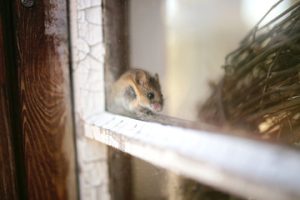Rats and mice carry several dangerous diseases, including plague, typhoid, and rickettsial infections. You can help reduce the risk of these diseases by avoiding direct contact with mouse droppings.
Keep trash cans tightly sealed and clean. Store lumber, wood piles, and rubbish away from buildings. Prune shrubbery and trees to reduce hiding places for rodents. Better to call Rodent Retreat experts to properly handle the issue.

Check for Nesting Sites
Rodents leave clues behind that let you know they’ve moved in. Droppings, dark brown marks on surfaces, and chewed wires are all signs of a rodent infestation. Observing behavior and nesting preferences can also reveal the type of rodent you’re dealing with. Mice are curious and tend to explore new areas, while rats are more cautious, building nests in familiar locations. Some rats are more likely to burrow in basements, crawl spaces, and under porches, while roof rats favor attics, rafters, and upper parts of homes and buildings.
Mice are particularly drawn to trash cans, so make sure you use a mouse-proof bin with a lid and close it regularly, both inside and out. Store food in airtight containers and don’t leave pet food out all day. You can also try using peppermint or clove oil as natural deterrents by placing cotton balls soaked in these oils in drawers and cabinets.
Both mice and rats can squeeze into openings the size of a quarter, so look for gnaw holes and smudges along walls near entry points. Rats have more robust teeth, so their gnaw holes are larger than those left by mice. You can seal cracks with steel wool, caulk, or hardware cloth to prevent rodents from making their way into your home. Weather stripping doors and windows can help as well.
Seal Up Holes
Mice can enter through gaps, cracks, or openings near pipes and utility lines. They also camp out in basements, crawl spaces, and attics, where they can nestle and breed. They sniff out tiny crumbs, birdseed, pet food, and other free meal tickets. They can gnaw through piping, creating a fire hazard and leading to costly repairs, and carry diseases that humans can contract (such as Hantavirus and Lassa Fever).
If you find droppings in the house or hear scratching, it may be time to call a pest control expert. They can determine the extent of the problem and identify possible entry points in and around your home.
The good news is, you can prevent mice infestations and make your home less attractive to rodents by taking several steps. Store food in airtight containers, keep garbage cans tightly closed and anchored to the ground with rubber cords, and remove wood piles from your property.
Discovering potential mouse entry points is the first step in preventing rodents. Look low and high, checking areas such as kitchen cabinets, baseboards, vents, and attic entry points. You can block a gap by using a spray foam that contains a bittering agent to deter gnawing; you can also lace the foam with metal shavings to strengthen it. Be sure to seal narrow gaps with 100% silicone caulk.
Use Traps
Often rodents get into the house through holes that don’t close properly, or through openings around pipes and electrical wiring. To prevent this, tighten the bolts on doors and windows; install fine wire mesh over openings into basements; and seal holes in walls and ceilings.
If you do find signs of a rat or mouse infestation, you may want to use traps to catch them. Choose traps based on the size of the animal you’re targeting; snap or spring-loaded traps are effective for mice and rats, while glue and live traps are more appropriate for larger rodents like squirrels, rabbits, and hamsters.
Place the traps around your home, ideally away from pets and children’s reach. Use a nonlethal bait like peanut butter or fruit. Place the traps near where you’ve seen rodent droppings and urine, or gnaw marks on baseboards or walls. You can also try setting traps in areas where you suspect they’re nesting, such as in attics and crawlspaces.
Keep in mind that nonlethal traps don’t always kill the animals immediately — they can starve to death or die from other causes, such as dehydration or infection. In addition, anticoagulant poisons can cause a slow, painful death for the rodent and harm other wildlife that might eat it. This is why it’s important to use only the amount of poison recommended on the label.
Contact a Pest Control Expert
Rodents gnaw their way into buildings, damaging property and causing discomfort for people inside. Rodents also carry diseases and can spread them to humans through their faeces and urine.
In the fall, as it gets cooler, mice and rats are looking for warmth, shelter, food, and water. Often, they get into homes and businesses by chewing through a gap in a foundation or cinder block wall. They can squeeze through holes the size of a quarter or less and can eat through many types of material, including concrete, wires, insulation, and sheetrock. They can also chew through gas lines and contaminate food. The EPA estimates that 25% of all fires “of unknown origin” are caused by rodents chewing on electrical wires.
Mice and rats are much more likely to stay in a home or business if there is a steady supply of food. This can be a result of garbage being left out or improperly stored food in a cupboard.
Take care to keep garbage tightly crated, and store all foods in containers with tight-fitting lids. Keep cupboards and counters free of crumbs and spills, and sweep regularly. Keep pet bowls clean, and don’t store pet food outside overnight. Keep gardens and hedges trimmed to avoid providing cover for rodents. Natural deterrents like peppermint oil and vinegar can help, and a cat (although not the best long-term solution) can scare away rodents with their scent.